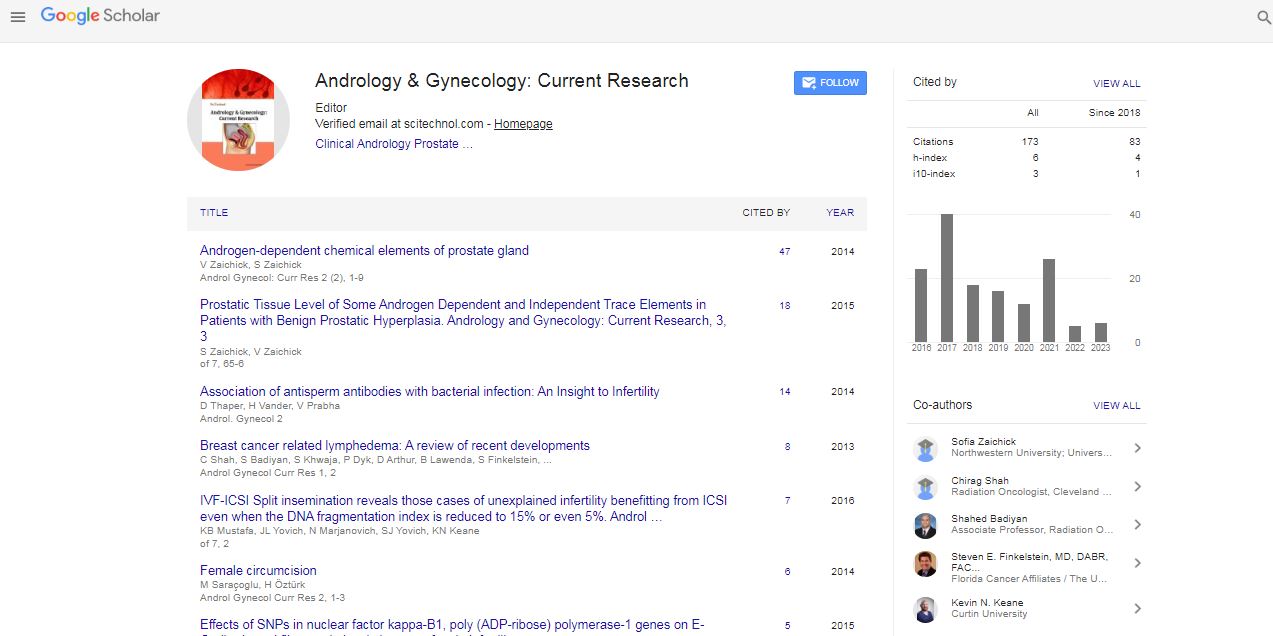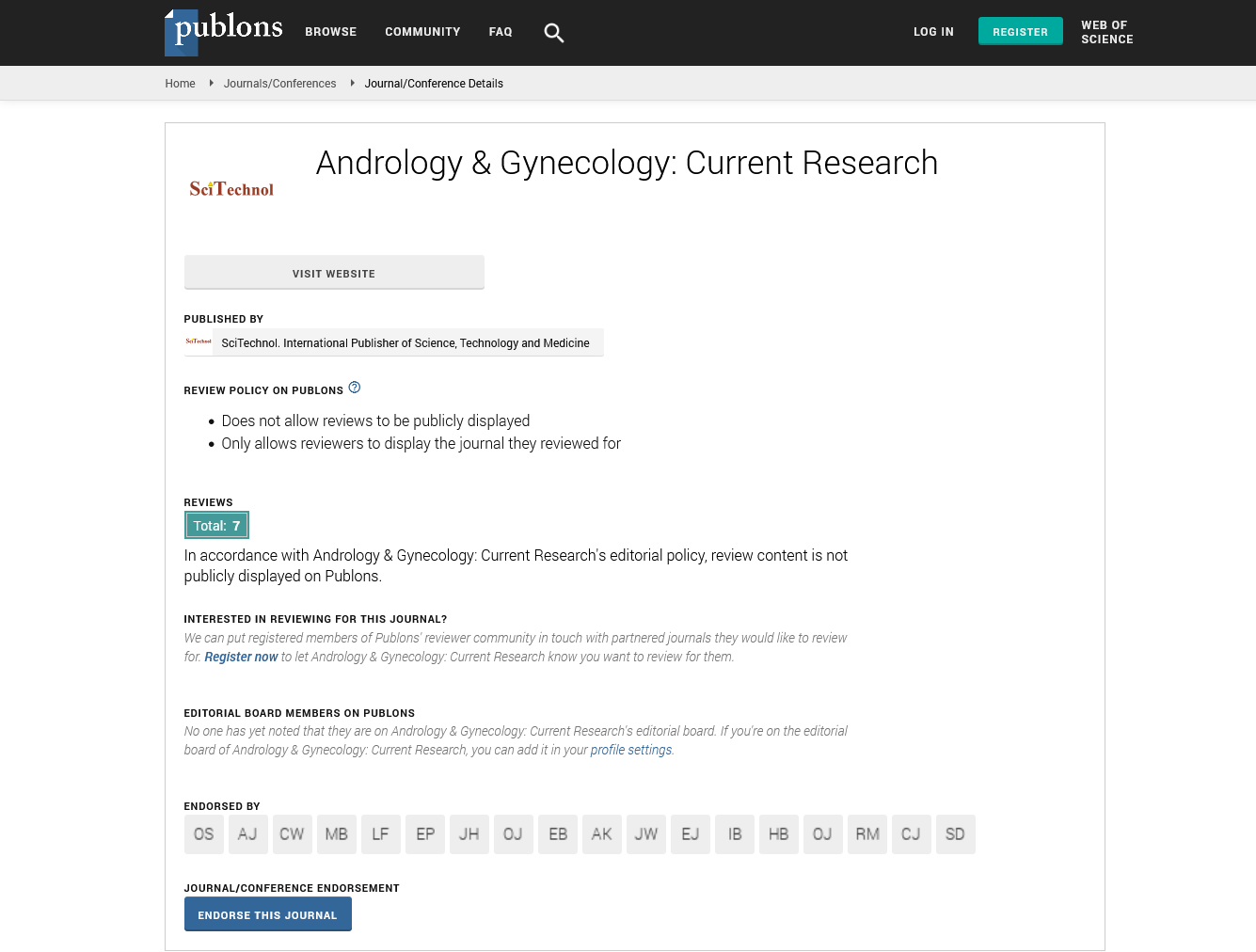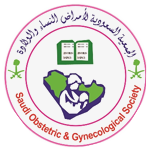Case Report, Agcr Vol: 9 Issue: 1
Role of Gynecologist in Hysterosalpingography: An Easy Test for Evaluation for Evaluation of Tubal Factor in Infertile Woman, Study in a Private Diagnostic Centre
Mala Banik*
Sir Salimullah Medical College, Dhaka, Bangladesh
*Corresponding Author:
Mala Banik
Sir Salimullah Medical College
Dhaka, Bangladesh
Tel: + 8801715088549
E-mail: malabanik@yahoo.com
Received: December 10, 2020 Accepted: December 18, 2020 Published: January 15, 2021
Citation: Banik M (2021) Role of Gynecologist in Hysterosalpingography: An Easy Test for Evaluation for Evaluation of Tubal Factor in Infertile Woman, Study in a Private Diagnostic Centre. Androl Gynecol: Curr Res 9:1.
Abstract
Background: Tubal factor is responsible for 25-40% of an infertile woman. There are three main modalities to detect tubal patency are Hysterosalpingography (HSG), SIS (Saline Infusion Sonography) and Laparoscopic Chromopertubation (Diagnostic Laparoscopy dye Test). Hysterosalpingography is a relatively noninvasive, easy procedure with rare complications.
Objective: To assess the tubal factors among infertile women by HSG. Age of the infertile women, type of infertility, duration of infertility, and history of abortion or MR are also analyzed.
Methodology: This cross-sectional study was carried out in a private diagnostic center, Dhaka, Bangladesh during the period of August 2016 to October 2018. 64 infertile women of reproductive age (21-40 years) were in the study for HSG to detect tubal factor.
Results: 58% of patients had secondary infertility. Majority of the subjects of both primary and secondary infertility (69%) were in the 21-40 years age group. 62.5% of patients had prolonged duration of infertility more than (4-7 years). 47% of patients of secondary subfertility had a history of abortion or MR. On HSG unicornuate uterus with one sided patent tube was found in 3% cases and the unilateral and bilateral tubal block was present in 32% and 22% cases respectively.
Conclusion: Hysterosalpingography remains the front-line imaging modality in the investigation of infertility. It is an accurate means of assessing the uterine cavity and tubal patency. It is an easy test and patient compliance is very good when the Gynaecologist introduces dye through the cervical catheter. In addition the Gynaecologist is very much familiar with vaginal operations and has immense knowledge of female anatomy so the pitfalls and misinterpretation can be avoided.
Keywords: Infertility, Hysterosalpingography, Gynaecologist.
Keywords
Infertility; Hysterosalpingography; Gynaecologist
Introduction
Infertility, a term that is traditionally used to describe a condition when a couple fail to conceive after 1 year of regular, unprotected intercourse [1]. The waiting period for 1 year is rationalized that 85%- 90% of couples conceive within 1 year [2]. 10% needs some help for getting pregnant [3]. The female partners need to be evaluated through the basic infertile workup which includes a thorough interview and clinical examination, assessment of ovulation and ovarian reserve, assessment of uterus and fallopian tubes [4]. The primary aim of the investigation is to provide an accurate diagnosis in a rational way with minimum intervention, in a short time, and with limited cost.
The tubal factor is responsible for 25%-40% of infertile women [5]. There are three main modalities to detect tubal patency are Hysterosalpingography (HSG), SIS (Saline Infusion Sonography) and Laproscopic Chromopertubation (Diagnostic Laparoscopic Test). Hystersalpingography is a relatively noninvasive, easy procedure with rare complications. Short procedure, usually completed within 30 minutes. SIS is the procedure where saline is introduced through the cervical catheter. Passage of fluid through the tube and fimbria end into the peritoneal cavity is assessed Sonographically by using transvaginal Sonography. An ultrasound machine and Sonologist is needed but during HSG Gynaecologist is alone can do it in the radiology department. Laparoscopic Chromopertubation: This has been the gold standard for investigating tubal patency. Furthermore, laparoscopy permits direct visualization of the whole peritoneal cavity, including other pathology such as perihepatic adhesions. An invasive, time consuming, and costly procedure. Anesthesia is required. Postoperative complications are more.
Hysterosalpingography is a relatively noninvasive, easy procedure with rare complication. Short procedure, usually completed within 30 minutes. Hysterosalpingography also gives valuable informations about the abnormalities of uterine cavity that cause infertility. The gynecologist is alone can do it in the radiology department. Royal college of obstetricians and gynecologists recommendations for tubal assessment [6]. Women who are not known to have comorbidities (such as pelvic inflammatory disease, previous ectopic pregnancy, or endometriosis) should be offered HSG to screen for tubal occlusion because this is a reliable test for ruling out tubal occlusion and it is less invasive and makes more efficient use of resources than laparoscopy. Hysterosalpingography is an x-ray examination of a woman’s uterus and fallopian tubes that uses a special form of x-ray called fluoroscopy and a contrast material. During a Hysterosalpingogram, the uterus and fallopian tubes are filled with a water-soluble contrast material which is passed through cervical catheter by the physician and the radiologist is able to use fluoroscopy to view and assess their anatomy and function. (Figure 1,2).

Figure 1: Normal HSG showing free spillage of dye through the both fallopian tube into the peritoneal cavity.

Figure 2: Abnormal HSG showing Right sided tubal block.
Uses of HSG
Hysterosalpingography is primarily used to examine infertile women by evaluating the shape and structure of the uterus, the patency of the fallopian tubes. The procedure can be used to investigate recurrent mid trimaster pregnancy loss to see congenital or acquire abnormalities of uterus such as bicornuate or unicornuate uterus, cervical incompetence, submucus fibroids and uterine synechae.
Steps of procedure
This examination is usually done on an outpatient basis between the 7th to 10th day of the menstrual cycle. The procedure is like a gynecological exam. The patient is positioned on her back on the exam table, with her knees bent or her feet held up with stirrups and a speculum is inserted into the vagina. The cervix is then cleansed, and a catheter is inserted into the cervix. The speculum is removed and the patient is carefully positioned underneath the fluoroscopy camera. The contrast material then begins to fill the uterine cavity, fallopian tubes and peritoneal cavity through the catheter and fluoroscopic images are taken. When the procedure is complete, the catheter will be removed and the patient will be allowed to sit up. The Hysterosalpingogram is usually completed within 30 minutes.
Complications of HSG
Two most common complications are pain and infection. Uterine contraction and discomfort due to introduction of contrast medium into the uterine cavity. The most common type of pain is abdominal colic caused by dilation of uterine cavity. A more diffused pain caused irritation of the peritoneum due to the contrast material. Pain can be reduced by NSAID, sedatives and antibiotics. Other side effects are Vasovagal reaction and allergic reaction to contrast media.
Objective of the study
- To assess the tubal factors among the infertile women by HSG.
- Age of the infertile women, type of infertility, duration of infertility and history of abortion or MR are also analysed.
Materials and Method
This observational, descriptive cross-sectional prospective study was carried out in a private diagnostic center, Dhaka, Bangladesh during the period of August 2016 to October 2018. 64 infertile women of reproductive age (21-40 years)were in the study for HSG to detect tubal factor.
Inclusion Criteria
- Woman fails to pregnant after 6 ovulatory cycles
- Women more than 35 years of age and infertility of more than 3 years
- Women of any age of poor ovarian reserve where quick treatment is needed
- History of abortions, MR and salpingectomy after ectopic pregnancy.
Exclusion Criteria
Active PID: The clinical assessment was done with a thorough history of female partner and was documented in present data sheet. Female history included menstrual history, past obstetrical history and past medical or surgical history were also documented. Collected data were compiled and expressed as proportion.
Results
Age of the infertile Woman (n=64), Shows that the majority (68.75%) cases are within the age of 22-34 (Table 1).
Table 1: Shows that majority (68.75%) cases are within the age of 22-34.
Duration of infertility among the infertile women (n=64), Shows majority (62.5%) cases suffered from 4-7 years of infertility (Figure 3).

Figure 3: Shows majority (62.5%) cases suffered from 4-7 years of infertility.
Type of infertility (n=64), Shows 59.37% cases are suffering from Secondary infertility (Figure 4).

Figure 4: Shows 59.37% cases are suffering from Secondary infertility.
History of Abortion, MR or Ectopic pregnancy among women suffering from secondary infertility (n=38), Shows 7.89% cases h/o ectopic and 47.36% h/o of abortion or MR (Figure 5).

Figure 5: Shows 7.89% cases h/o ectopic and 47.36% h/o of abortion or MR.
Hysterosalpingography findings among the infertile women (n=64), show 32.9% cases have right or left tubal block (Table 2).
Table 2: Shows 32.9% of cases have the right or left tubal block.
Discussion
The majority of both the primary and secondary infertility groups were in the age group 22-34 years which is supported by studies done by Masuda et al. [7] Abubakar et al. [8], Kiguli Malwadde [9] and Byanjima.
In the study we found that most of the woman undergoing hysterosalpingography had secondary sub-fertility (59.37%). Similarly secondary infertility was found to be common more than primary in some other studies in home [7] and abroad [8,9,11]. The high prevalence of secondary infertility could be due to facts that 50%-80% infertility in sub-saharan Africa usually follows ascending genital infection from complicated abortions and unsupervised deliveries resulting in tubal pathogenesis [12].
In the majority of cases (62.5%) duration of infertility was 4-7 years. In the studies done by Asma et al. [7], Haider et al., Santhalia et al., [13], Abdullah [14], Kabala [11] mean duration of infertility at the time of presentation were 2.5 years, >2 years, 3.9 years, 3-8 years and 5years respectively.
Regarding past illness among the secondary infertile women. History of abortion, MR, 47.39% has h/o of ectopic pregnancy. Asma et al. [7] show 18% history of puerperal or Post abortal infection. This defers from study done by Shayela where puerperal sepsis was present in 30% of cases [15]. Puerperal sepsis more common maybe due to this study was done 30 years back when intranatal care and Postnatal care was poor.
On HSG, we found 32.9% shows unilateral tubal block, 21.9% bilateral block. These findings supported by number of studies of Asma et al. [7], Mughissi [16-22]. On the other hand studies by Buker et al. [22] and Nizoku et al. [23] showed that the commonest abnormal HSG findings were pelvic adhesion and Fibroid respectively.
Conclusion
In conclusion, the present study depicted that the implementation of cognitive enhancement package has positive effects on the self-care activities, group interaction and cognitive functioning of psychiatric inpatients which additionally also transforms their self-esteem positively. These results support investment in non-pharmacological programs like Cognitive Enhancement Package as a supportive pillar to psychopharmacology in upgrading the wellbeing of individuals with various types of psychiatric disorders. Therefore, these results are encouraging and promoting the efforts on the behalf of psychiatric nurses warranting the conduction of further research in such field.
References
- Practice Committee of the American society for Reproductive Medicine (2013) Definitions of Infertility and recurrent pregnancy loss: A committee opinion. Fertile Steril 99:63.
- Wang X, Cheng C, Wang L, Chen D, Guang W, et al. (2003) Conception, early pregnancy loss, and time to clinical pregnancy: A population-based prospective study. Fertil Steril 79:577-584.
- Begum R (2019) Patient Management in Obstetrics and Gynaecology. Jaypee Brothers India.
- Mukhergee GG, Khastgir G, Chattopadhyay R (2018) Practical guide in infertility. Jaypee Brothers India.
- Konar H (2017) Manual of Obstetric and Gynecology for the post graduates. Jaypee Brothers India.
- Khan MI, Suha J, Jerin J, Shermin S, Chowdhury TA (2014) Hysterosalpingography in Infertility. Delta Med Col J 2:9-12.
- Abubakar A, Ali YM, Nwobi IC, Nkubli BF, Miftaudeen MN, et al. (2016) Common Hysterosalpingography Protocols and Findings among Infertile Women in a Tertiary Healthcare Institution in Northeast, Nigeria. IOSR-JDMS 15:124-127.
- Malwadde EK, Byanyima RK (2004) Structural Findings at Hysterosalpingography in Patients with Infertility at Two Private Clinics in Kampala, Uganda. Afr Health Sci 4:178-181.
- Haider G, Rani S, Talpur S, Zehra N, Munir A (2010) Laparoscopic Evaluation of Female Infertility. J Ayub Med Coll Abbottabad 22:136-138.
- Kabala RB (2011) Imaging Findings in Infertile Female Patients Who Underwent Hysterosalpingography Investigation at Muhimbili National Hospital, Tanzania.
- Oguntoyinbo AE, Adesina KT, Olarinoye AO, Aboyeji AP, Olanrewaju WI, et al. (2014) Pre HSG microbial isolates from endocervical swabs in infertile women in illorin Nigeria. West Afr J Radiol 21:59-63.
- Santhalia PK, Grupta MK, Uprety D, Ahmad K, Ansari S, et al. (2013) Role of radiographic Hysterosalpingography in Infertility in eastern Nepal, NJR 3:59-66.
- Abdalla MN (2011) Epidemiology of Infertility in Gezira Region, Central of Sudan. RJMSCI 5:56-60.
- Shayela S (1989) A Clinical Study of 100 Cases of Infertility Attending the Infertility Clinic of IPGMR, Dhaka
- Moghissi KS, Sim GS (1975) Correlation between Hysterosalpingography and Pelvic Endoscopy for Evaluation of Tubal Factors. Fertil steril 26:1178-1181
- Tvarijonavieiene E, Nadisauskiene RJ (2008) The Value of Hysterosalphingogram in Diagnosis of Tubal Pathology among Infertile Patients. Medicina (Kaunas) 44:439-448.
- Bello TO (2006) Tubal Abnormalities on Hysterosalpingography in Primary and Secondary Infertility. WAJM 2:130-133.
- Okafor CO, Okafor CI, Okpala OC, Umeh E (2010) The Pattern of Hysterosalpingographic Findings in Women Being Investigated for Infertility in Nnewi, Nigeria. Niger J Clin Pract 13:264-267.
- Ahmadi F, orbati L, Akhbari F, Shahrzad G (2013) Appearance of Uterine Scar Due to Previous Cesarean Section on Hysterosalpingography: Various Shapes, Locations and Sizes. Iran J Radiol 10:103-110.
- Bhindi R (2011) Imaging findings in infertile female patients who underwent HSG investigation at Muhimbli national hospital.
- Bukar M, Mustapha Z, Takai UI, Tahir A (2011) Hysterosalpingograhy findings in infertile women: A seven year review. Niger J Clin Pract 14:168-170.
- Njoku J, Chibuzo AL, Cletus EU (2012) Common Hysterosalpingographic Findings in Infertility Cases in Lagos State, Nigeria JARN 26:1-7.
 Spanish
Spanish  Chinese
Chinese  Russian
Russian  German
German  French
French  Japanese
Japanese  Portuguese
Portuguese  Hindi
Hindi 


